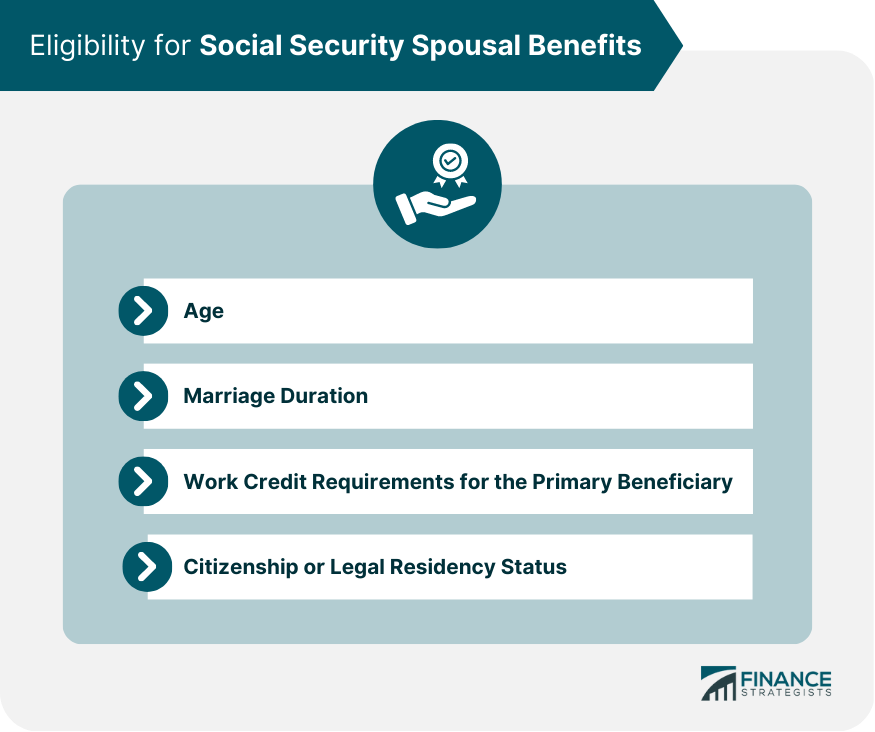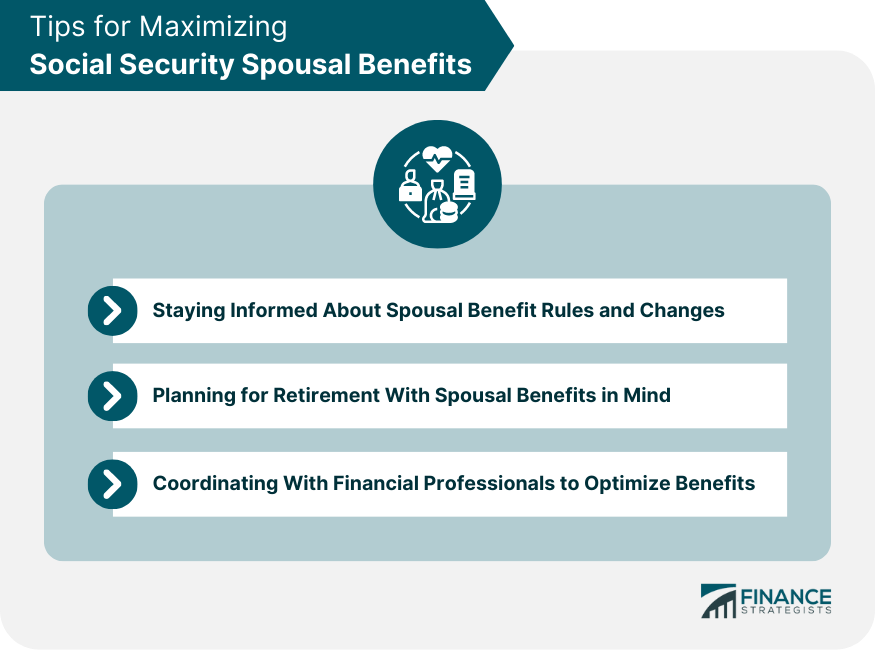Social Security spousal benefits are those available to the spouse of a retired or disabled worker who is eligible for Social Security retirement or disability benefits. Spousal benefits are designed to provide additional income to married couples who may have only one wage earner, or where one spouse earned significantly more than the other during their working years. Being knowledgeable about spousal benefits can help couples make informed decisions about when to claim benefits and maximize their retirement income. Several factors influence Social Security spousal benefits, including eligibility requirements, benefit calculations, claiming strategies, and taxation. Spouses can claim spousal benefits as early as age 62, but the benefit amount will be reduced if claimed before their Full Retirement Age (FRA). To qualify for spousal benefits, couples must be married for at least one year. Divorced individuals may also be eligible if they were married for at least 10 years and have not remarried. The primary beneficiary must have earned enough work credits (typically 40) to qualify for Social Security retirement benefits for their spouse to be eligible for spousal benefits. Both the primary beneficiary and their spouse must be U.S. citizens or legal residents to qualify for spousal benefits. Spousal benefits are calculated as a percentage of the primary beneficiary's Primary Insurance Amount (PIA), with the maximum benefit amount being 50% of the primary beneficiary's PIA. The spousal benefit does not affect the primary beneficiary's benefit amount. Both partners can receive their benefits independently. Claiming spousal benefits before FRA will result in reduced benefits, while waiting until FRA allows the spouse to receive the full 50% of the primary beneficiary's PIA. There is a maximum limit on the total benefits a family can receive, which may affect the spousal benefit amount if multiple family members are receiving benefits based on the primary beneficiary's work record. The Full Retirement Age for spousal benefits is the age at which the spouse can claim their full spousal benefit, which is based on their birth year and ranges from 65 to 67. Claiming spousal benefits before FRA will result in a permanent reduction in the benefit amount. Delaying the claiming of spousal benefits beyond FRA does not result in increased benefits, unlike individual retirement benefits. Couples should consider factors such as their health, financial needs, and life expectancy when deciding when to claim spousal benefits. Some individuals may be eligible to use the restricted application strategy, allowing them to claim spousal benefits while delaying their own retirement benefits to earn delayed retirement credits. Couples should consider coordinating spousal benefits with their individual retirement benefits to maximize their total retirement income. Divorced individuals may be eligible for spousal benefits based on their ex-spouse's work record if they were married for at least 10 years, have not remarried, and are at least 62 years old. Remarriage generally disqualifies an individual from receiving spousal benefits based on their ex-spouse's work record. However, if the subsequent marriage ends, the individual may regain eligibility for spousal benefits from their previous marriage. Divorced individuals should understand the rules and claiming strategies related to spousal benefits based on their ex-spouse's work record to maximize their retirement income. Surviving spouses are eligible for survivor benefits based on their deceased spouse's Social Security record, provided they meet certain age and marriage duration requirements. Spouses may be eligible for both spousal and survivor benefits but cannot receive both simultaneously. They should choose the higher of the two benefits to maximize their retirement income. Surviving spouses should understand the rules and strategies for coordinating survivor benefits with spousal benefits to ensure financial stability during their retirement years. Spousal benefits may be subject to federal income tax, depending on the couple's combined income. State income tax rules regarding spousal benefits vary. Couples should be aware of their state's tax rules and consider the impact on their retirement income. There are strategies available to minimize the taxation of spousal benefits, such as managing other income sources and timing withdrawals from retirement accounts. Couples should stay informed about the rules governing spousal benefits and any changes to the Social Security system that could affect their retirement planning. Incorporating spousal benefits into retirement planning can help couples ensure a more secure and comfortable retirement. Working with financial professionals can help couples navigate the complexities of spousal benefits and develop strategies to maximize their retirement income. Social Security spousal benefits play a vital role in retirement planning for married couples, offering additional financial support to help ensure a secure and comfortable retirement. Gaining a thorough understanding of the eligibility requirements, benefit calculations, claiming strategies, and taxation implications is crucial for optimizing these benefits and crafting a comprehensive retirement plan. Couples who stay informed about the rules governing spousal benefits and coordinate these benefits with other retirement income sources can better prepare for a financially stable retirement. A proactive approach to retirement planning, which incorporates Social Security spousal benefits, can help couples maximize their overall retirement income and safeguard their financial well-being during their golden years. Collaborating with financial professionals and remaining informed about the latest developments in Social Security spousal benefits can enhance one's ability to navigate the complexities of retirement planning. Ultimately, understanding and optimizing Social Security spousal benefits is essential for achieving a fulfilling and financially secure retirement for both partners.What Are Social Security Spousal Benefits?
Eligibility Requirements for Social Security Spousal Benefits
Age
Marriage Duration
Work Credit Requirements for the Primary Beneficiary
Citizenship or Legal Residency Status

Calculating Social Security Spousal Benefits
Determining the Spousal Benefit Amount
Interaction With the Primary Beneficiary's Benefit
Impact of the Claiming Age on Spousal Benefits
Maximum Family Benefits
Full Retirement Age and Spousal Benefit Adjustments
Definition of Full Retirement Age (FRA) for Spousal Benefits
Early Claiming and Reduced Spousal Benefits
Delayed Retirement and Spousal Benefits
Claiming Strategies for Social Security Spousal Benefits
Timing of Claiming Spousal Benefits
Restricted Application Strategy
Coordinating Spousal Benefits With Individual Benefits
Social Security Spousal Benefits for Divorced Individuals
Eligibility Requirements for Divorced Spouses
Impact of Remarriage on Spousal Benefits
Claiming Strategies for Divorced Individuals
Survivor Benefits and Spousal Benefits
Eligibility for Survivor Benefits
Interaction Between Spousal and Survivor Benefits
Claiming Strategies for Maximizing Survivor Benefits
Taxation of Social Security Spousal Benefits
Federal Income Tax Implications
State Income Tax Implications
Strategies to Minimize Taxation
Tips for Maximizing Social Security Spousal Benefits
Staying Informed About Spousal Benefit Rules and Changes
Planning for Retirement With Spousal Benefits in Mind
Coordinating With Financial Professionals to Optimize Benefits

Conclusion
Social Security Spousal Benefits FAQs
Social Security spousal benefits are payments made to the spouse of a Social Security recipient. These benefits are based on the earnings record of the Social Security recipient and can provide an additional source of retirement income for the spouse.
To be eligible for Social Security spousal benefits, you must be married to a Social Security recipient who is receiving retirement or disability benefits, or who has reached full retirement age but has not yet claimed benefits.
The amount of Social Security spousal benefits is based on the earnings record of the Social Security recipient. The spousal benefit amount is equal to up to 50% of the Social Security recipient's benefit amount.
Yes, you can receive Social Security spousal benefits and still work. However, if you start receiving benefits before your full retirement age and earn more than a certain amount, your benefits may be reduced.
If your spouse dies and they were receiving Social Security benefits, you may be eligible to receive survivor benefits. Survivor benefits are based on the earnings record of the deceased spouse and can provide an additional source of retirement income for the surviving spouse.
True Tamplin is a published author, public speaker, CEO of UpDigital, and founder of Finance Strategists.
True is a Certified Educator in Personal Finance (CEPF®), author of The Handy Financial Ratios Guide, a member of the Society for Advancing Business Editing and Writing, contributes to his financial education site, Finance Strategists, and has spoken to various financial communities such as the CFA Institute, as well as university students like his Alma mater, Biola University, where he received a bachelor of science in business and data analytics.
To learn more about True, visit his personal website or view his author profiles on Amazon, Nasdaq and Forbes.











